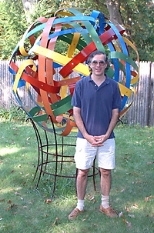If a polyhedron were flat, MIT's next artist-in-residence would have the shape emblazoned on his chest. Alumnus George W. Hart is "polyhedron man," the sculptor, scholar, engineer, educator, computer scientist and mathematical magician whose passion for the three-dimensional form with flat polygon sides has made him a superhero across disciplines in the arts and the sciences.
Hart, who earned the S.B. in mathematics in 1977 and the Ph.D. in electrical engineering and computer science (EECS) in 1987, was brought to campus by recently named MacArthur Fellow Erik Demaine, an assistant professor in EECS. Hart will share his artwork with a general audience tomorrow (Oct. 30); talk more technically about its mathematical and computational origins on Friday, Oct. 31; and hold what Hart likes to call an art "barn-raising" on Monday, Nov. 3, when he and 30 students will build a sculpture intended for display in the Stata Center.
"Taking a break to be part of a group sculpture assembly and thinking about the beauty of geometric forms should be a creative recharge for everybody involved," said Demaine, who admires the published author and patent-holder for being as multidimensional as the objects that fascinate him.
Hart's work involves both calculation and surprise. He said all his structures begin with patterns that, once realized concretely, present him with wonderful features he hadn't always anticipated.
"I mainly evaluate polyhedra in terms of their aesthetic appeal: what's visually, geometrically or tactilely of interest. Making new polyhedra isn't a big deal," Hart explained, referring to a practical and interactive computer algorithm he wrote to generate novel versions of the shape. "But finding ones that are interesting--that have nice properties--is what I'm after. The real art is how to make interesting geometric forms in one material."
Noting that different viewers of his sculptures tend to find the same aspects pleasing, Hart said he believes there must be a universal geometric aesthetic that appeals across cultures and time. In fact, as models of symmetry and perspective or symbols for profound religious or philosophical truths, polyhedra have been known to fascinate ancient Greeks like Plato and Pythagoras, Renaissance figures like Leonardo da Vinci, and 20th-century artists like M.C. Escher.
Polyhedra can be a way of rationalizing art or seeing the world in a new way. And as Hart has shown with his prized sculpture--the "Millennium Bookball," a giant mobile fusing 60 gold-leafed, wooden "books of the century" chosen by locals who helped Hart build the piece for his hometown library in Northport, N.Y.--they can also just be fun.
On Hart's web site at http://www.georgehart.com, he playfully reveals that he's waged cross-country paper-polyhedra challenges, popularized a cookie recipe as a tribute to an extinct marine fossil, helped name a unique crystal shape found on Mars and graced a Geek Site of the Day.
Hart also has a serious mission: "I try to teach problem-solving in anything I can. I try to convey to students that people don't hire you to solve old problems, but to solve new ones."
As an undergraduate at MIT, Hart went to as many classes and lectures as he could get away with, sometimes sitting in when he wasn't actually registered. He remembers professors being friendly and accessible. "They say going to MIT is like taking a sip from a fire hose, and for me it was just terrific," he said. "I was ready for it."
He has also worked at the Institute as a computer scientist in both Lincoln Laboratory and the Energy Laboratory.
What keeps Hart coming back? "I like the spirit and the people. They just have an attitude that really resonates well with me, a certain kind of intellectual curiosity and follow-through."
A version of this article appeared in MIT Tech Talk on October 29, 2003.






